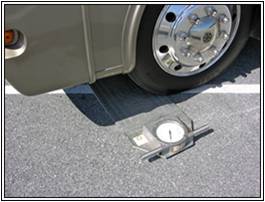It is absolutely essential that an RVer have an understanding of RV Weights and Measures. Trailers and their towing vehicles must be matched so the tow vehicle can handle the weight on the rear axle or bumper. The tow vehicle must be capable of towing the loaded weight of the trailer on the road that will be encountered. The towing vehicle must also be capable of stopping in a safe distance with the trailer attached. Motorhomes must not be loaded beyond published weight specifications. All of this is about safety of both the RVer and passengers, but others on the road nearby.
RV’s that are overweight can experience premature tire failure as well as severe handling problems. Weight distribution is also an important issue. Too much weight on one side can cause handling issues as well as tire wear problems. Trailer weight distribution must be set so that the proper amount of weight is forward on the hitch or pin box in the case of fifth wheel trailers.
Overweight units that are involved in an accident may be weighed by the insurance company and claims denied if the unit is found to exceed critical measures.
Here is a list of commonly used RV weight terms.
Tires and RV Weights and Measures
Tires are undoubtedly the most important component of the RV’s chassis. Besides supporting the vehicle’s weight, they transfer acceleration and braking forces to the road as well as keep it going in the proper direction.
Tire manufacturers provide charts for each type of tire with what tire pressure is required to support a particular amount of weight. RV manufacturers must select a tire that will support the weight of the properly loaded RV. We all know tire failures can be catastrophic. A front motorhome tire failure will certainly cause the rig to veer suddenly in the direction of the bad tire. Later on we will discuss a method to safely guide a motorhome with a blown front tire to a stop. Tires can sometimes literally explode and take out fenders, holding tanks, and anything else close to the bad tire.
Weighing your RV

The best way to know if your RV is in compliance with its applicable weight ratings is to weigh it. In order to know everything, all corners must be weighed. On a motorhome, that means each front wheel and each set of dual tires. If there is a tag axle, then each tire position on that axle must also be weighed. This will also tell you how much air pressure should be in the tires on either front, rear, or tag axle.
When RV weight ratings are exceeded, the RV is operating beyond its design parameters and is unsafe. For a motorhome, this means steering, suspension, transmission, axles and other chassis components are beyond their design limits and can fail prematurely. I believe the worst scenario here is brakes pushed beyond their limits can fade and not stop the rig in a normal stopping distance. This is the reason most states require auxiliary braking systems for vehicles towed behind motorhomes. It’s hard to emphasize this point enough. All that weight behind you can push you through an intersection if there are no brakes on the towed vehicle. Your insurance company will most likely not cover you in that situation. Here is how to weigh your RV.
